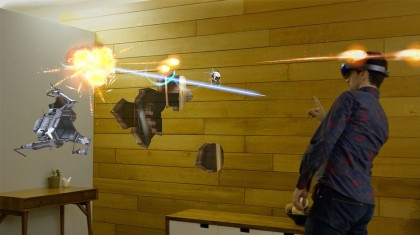Microsoft HoloLens offers a kind of magic virtual reality can't
HoloLens isn't without its limits, but those I can live with

Someone 10 feet away is pinching furiously at the air, aiming in my direction. To an observer not wearing Microsoft HoloLens, this person might look foolish, even bizarre.
Not to me. I'm pinching at him just as ardently, as well as five other people in a room of more than 50.
The initiated know we're playing a game. Each of us has a demon-faced avatar called a Polly just above our shoulder, and the pinching motion - meeting index finger to thumb - sends fiery metal balls at our opponents' avatars.
But, if we band together and shoot the balls at a blue orb floating over a metallic claw-like base that only the six of us can see, we can open up a hole in the floor (or table, or wherever) and attack an avatar located below.
My pod of players are all connected to the same computer, which is acting as a hub, allowing us to see each others' color-coded Polly and the orb we need to destroy. Other groups have their own hub, so while we can see them milling around the room and pinching the air, we aren't interacting with them. They aren't in our game.
I can walk anywhere and still locate the players I need to shoot at thanks to their avatars. It's like having robotic vision that allows you to see your "enemy" in a crowd that includes people who aren't your targets, though in a much less sinister sense.
The blue orb and base serve as the focal point to our wanderings. We can even move this structure as a team if we circle around it, shift as a group and one of us sets it down with a pinching motion. Anyone can utter "Reset location" and the base will unlatch, letting us move it once again until another player selects a new spot for it.
Sign up for breaking news, reviews, opinion, top tech deals, and more.
It's this simple, giddy game played at Build 2016 during my second-ever Holographic Academy that crystallized for me the awesome potential of HoloLens. Unlike Oculus Rift or HTC Vive, VR viewers that offer amazing immersion in unreal realms, Microsoft's AR headset turns the world into your own augmented reality playground.

The power of reality
HoloLens, which began shipping to developers last week, is not a virtual reality headset that completely immerses you in a game or experience.
Instead, it overlays digital images onto the real world. You can still see everything in your environment, from couches to tables to computers to people, but if a HoloLens experience is activated, you'll also see things that aren't really there, like vibrant Pollys and prismatic shards as that blue orb is blown up.
HoloLens' mixed reality induces a psychedelic feeling: I'd be having a perfectly normal conversation with my Holographic Academy mentor, but if I looked away or another player walked into my field of view, I'd see their bouncing Polly or the pulsating base. My mentor couldn't see any of this because she wasn't wearing HoloLens, but I could.
The other virtual reality headsets on the market transport you to other places, and all the major ones do this excellently in their own right. HTC Vive, as our Nick Pino describes in his review of the headset, is the best of them all at this.
HoloLens will take you to another planet, like Mars, but what I've found most intriguing during my time with the headset is that it adds magic to the real world. Any room can become something wonderful with mixed reality. Now, to make it even better, Microsoft is throwing in other people.
With most VR experiences I've tried, there's a wall of sorts between myself and what I'm seeing, no matter how real it is, namely because I'm not actually in that world. That wall disintegrates wearing HoloLens.
All the world's a stage, Shakespeare wrote. With HoloLens, all the world's your play thing.

Michelle was previously a news editor at TechRadar, leading consumer tech news and reviews. Michelle is now a Content Strategist at Facebook. A versatile, highly effective content writer and skilled editor with a keen eye for detail, Michelle is a collaborative problem solver and covered everything from smartwatches and microprocessors to VR and self-driving cars.